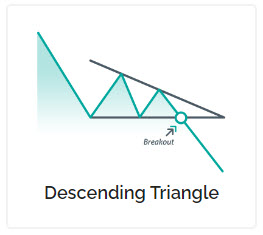In the world of financial markets, trading patterns can provide valuable insights into potential price movements. One such pattern that traders often analyze is the descending triangle. This article delves into the concept of descending triangle trading, exploring its characteristics, strategies, and potential profitability. Whether you are a novice trader or an experienced investor, understanding the dynamics of descending triangle trading can enhance your ability to make informed decisions and capitalize on market opportunities.
Descending Triangle Trading: Unveiling the Pattern
The descending triangle is a bearish continuation pattern that forms during a downtrend. It is characterized by a series of lower highs forming a horizontal line of support. Traders often consider this pattern as a signal of further price decline, as it suggests that selling pressure is outweighing buying pressure in the market.
Identifying
When analyzing price charts, traders look for specific characteristics to identify a descending triangle pattern. These include:
- Converging Trendlines: The descending triangle is formed by connecting the lower highs with a descending trendline and the horizontal support line.
- Horizontal Support: The lower line of the triangle acts as a support level, representing the point at which buying pressure counters selling pressure, preventing further decline.
- Decreasing Volume: During the formation of a descending triangle, trading volume tends to diminish, indicating a lack of enthusiasm from buyers.
Trading Strategies for Descending Triangles
Trading strategies based on the descending triangle pattern aim to capitalize on the anticipated price breakdown. Here are some popular approaches used by traders:
1. Breakout Strategy
A breakout strategy involves waiting for a confirmed breakdown below the horizontal support line. Traders typically set sell orders below the support level to capture potential profits as the price continues its descent. It’s crucial to wait for a strong confirmation of the breakdown, often accompanied by increased volume, to avoid false signals.
2. Retest Strategy
The retest strategy focuses on waiting for a retest of the broken support level from below. Once the price breaks below the support line, it may later retrace and test the former support as resistance. Traders can then look for short-selling opportunities when the price fails to surpass the previous support-turned-resistance level.
3. Price Target Strategy
Another approach is to calculate a price target by measuring the height of the triangle from the support line to the highest point of the descending trendline. Traders project this distance downward from the breakout point to estimate a potential target for the price decline. This strategy helps set profit targets and manage risk-reward ratios.
FAQ’s on Descending Triangle Trading
- Q: How reliable is the descending triangle pattern in trading? A: The descending triangle pattern is considered reliable, but like any technical analysis tool, it is not foolproof. Traders often use it in conjunction with other indicators and factors to validate their trading decisions.
- Q: Can the descending triangle pattern occur in any timeframe? A: Yes, the descending triangle pattern can occur in various timeframes, including intraday, daily, weekly, or even monthly charts. The principles and strategies remain the same, regardless of the timeframe.
- Q: Are there any other triangle patterns I should be aware of? A: Yes, apart from the descending triangle, there are two other common triangle patterns: ascending triangle and symmetrical triangle. Each pattern has its own unique characteristics and trading strategies.
- Q: How do I determine the breakout direction of a descending triangle? A: The breakout direction of a descending triangle can be determined by the prevailing trend. If the triangle occurs during a downtrend, a breakdown below the support line is more likely. Conversely, if it forms during an uptrend, a breakout to the upside may be expected.
- Q: Can the descending triangle pattern be used for short-term trading? A: Yes, the descending triangle pattern can be utilized for short-term trading. However, it is important to consider other factors such as market conditions, volatility, and the presence of any significant news or events that could impact the price.
- Q: Are there any risks involved in trading descending triangles? A: Like any trading strategy, there are risks associated with descending triangle trading. False breakouts, sudden reversals, and unexpected market conditions can impact the success of the strategy. Risk management and proper trade execution are essential.
Descending triangle trading is a valuable skill for traders seeking to capitalize on bearish market conditions. By identifying the pattern, understanding its characteristics, and employing appropriate strategies, traders can enhance their ability to make profitable trading decisions. However, it is important to remember that no trading strategy is infallible, and risk management should always be a priority. So, whether you are a seasoned trader or a beginner, make sure to apply proper risk management techniques and continuously educate yourself to stay ahead in the dynamic world of financial markets.
Sources
- Investopedia: Learn more about descending triangles and their significance in technical analysis.

